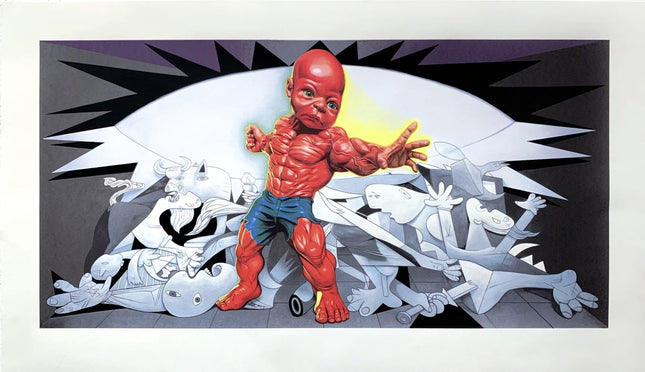
Gray/Grey
-

Ron English- POPaganda Temper Tot Tramples Guernica Silkscreen Print by Ron English- POPaganda
Temper Tot Tramples Guernica Silkscreen by Ron English- POPaganda Hand-Pulled 4-Color Screen on 320gsm Coventry Rag Paper Mural Pop Street Art Artwork. 2021 Signed & Numbered Limited Edition of 199 Artwork Size 43x25 "Temper Tot Tramples Guernica" is an evocative piece by Ron English- POPaganda, a seminal figure in Street Pop Art and Graffiti Artwork. English, known for his masterful blending of high and low cultural touchstones, presents a 2021 silkscreen juxtaposing his iconic Temper Tot character against the backdrop of Picasso's historic mural "Guernica." This work is part of a limited edition series, meticulously hand-pulled on 320gsm Coventry Rag Paper, known for its exceptional quality and durability. The artwork is substantial, with an image measuring 19 by 38 inches and paper size extending to 25 by 43 inches, allowing the visual drama and detail to unfold powerfully before the viewer. English's work is part of a limited run of 199 pieces, along with artist proofs and foundation proofs, each signed and numbered in pencil by the artist. This specificity in documentation provides collectors with a guarantee of the artwork's authenticity and exclusivity. Ron English- POPaganda's artwork is recognized for critically engaging with cultural narratives and iconic figures. In "Temper Tot Tramples Guernica," English superimposes his superhero-like toddler over Picasso's black-and-white portrayal of the tragedies of war, thereby infusing the somber historical narrative with a contemporary and ironic twist. The Temper Tot, with his exaggerated musculature and childlike impulsivity, becomes a symbol of unchecked power and emotional rawness, a stark contrast to the solemnity of Picasso's anti-war masterpiece. The choice of the Temper Tot, one of English's most famous characters, known for embodying the artist's critique of American consumerism and corporatization, presents a compelling dialogue between past and present political discourse. This dialogue is further emphasized by the vibrancy of the silkscreen technique, a hallmark of English's practice, which brings the historical into the immediate and visceral realm of street art. "Temper Tot Tramples Guernica" was printed by the renowned Gary Lichtenstein Editions and distributed by WCC Editions, ensuring the highest level of craftsmanship in producing this print. The paper's hand-deckled edges contribute to the unique character of each piece, as they echo the textured, often imperfect surfaces of urban environments where street art naturally resides. The mural from which this print originated was created in 2015 under the auspices of the Lisa Project NYC, further cementing English's role in the urban landscape of public art. By moving from the transient medium of murals to the permanence of limited edition prints, English allows for a wider dissemination of his ideas, enabling a broader audience to engage with his provocative juxtapositions and vibrant imagery. Ron English- POPaganda's "Temper Tot Tramples Guernica" serves as a poignant reminder of the power of Street Pop Art to comment on society, offering a bridge between historical consciousness and contemporary critique. It stands as a testament to the potential of street art to infuse spaces, whether public or private, with layered meanings and vibrant visual impact.
$1,648.00


